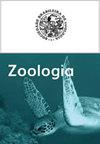DNA barcoding of a tropical anguillid eel, Anguilla bicolor (Actinopterygii: Anguilliformes), in Indo-Pacific region and notes on its population structure
IF 1.8
4区 生物学
Q4 ZOOLOGY
引用次数: 3
Abstract
The tropical anguillid eel, Anguilla bicolor McCelland, 1844, includes two subspecies, Anguilla bicolor bicolor McCelland, 1844 and Anguilla bicolor pacifica Schmidt, 1928, and is distributed across the Indo-Pacific region. Although A. bicolor is widely distributed and recognized as an important fish resource in the Indo-Pacific region, few studies have been conducted on its genetic variation and population structure. DNA barcoding of A. bicolor specimens collected in the Indo-Pacific region was carried out in this study using mitochondrial cytochrome c oxidase subunit I. Anguilla bicolor was found to diverge genetically, which supported its classification into two different subspecies. In addition, our study showed that A. bicolor bicolor had two genetically distinct populations/groups, and these different populations co-occur geographically in Indonesia and Malaysia in the eastern Indian Ocean. Our findings suggest that the eel larvae might be transported from at least two geographically different spawning grounds in the Indian Ocean, and then recruited to and settled in the same habitats in Indonesian and Malaysian waters. The molecular evidence calls for further research on the life history, stock assessment and protection of the populations of A. bicolor bicolor in Indonesia and Malaysia.印太地区一种热带鳗鲡,双色鳗鲡的DNA条形码及其种群结构注释
热带鳗鲡,Anguilla bicolor McCelland, 1844年,包括两个亚种,Anguilla bicolor McCelland, 1844年和Anguilla bicolor pacifica Schmidt, 1928年,分布在印度-太平洋地区。虽然双色刺鱼在印度-太平洋地区分布广泛,是公认的重要鱼类资源,但对其遗传变异和种群结构的研究却很少。本研究利用线粒体细胞色素c氧化酶亚基i对印度-太平洋地区采集的双色鳗鲡标本进行DNA条形码分析,发现双色鳗鲡在遗传上存在分化,这支持其分为两个不同的亚种。此外,我们的研究表明,双色古猿有两个遗传上不同的种群/群体,这些不同的种群在地理上共同出现在东印度洋的印度尼西亚和马来西亚。我们的研究结果表明,这些鳗鱼幼虫可能是从印度洋至少两个地理位置不同的产卵地运送过来的,然后被招募到印度尼西亚和马来西亚水域的相同栖息地并定居下来。这些分子证据表明,在印度尼西亚和马来西亚两国对双色刺槐的生活史、种群评估和种群保护等方面需要进一步研究。
本文章由计算机程序翻译,如有差异,请以英文原文为准。
求助全文
约1分钟内获得全文
求助全文
来源期刊

Zoologia
生物-动物学
自引率
0.00%
发文量
15
期刊介绍:
Zoologia, the scientific journal of the Sociedade Brasileira de Zoologia (SBZ), is an international peer-reviewed, open-access Zoological journal that publishes original research on systematics, evolution, taxonomy, nomenclature, biogeography, morphology, physiology, biology, ecology, symbiosis, conservation, behavior, genetics and allied fields. The journal, formerly known as Revista Brasileira de Zoologia, publishes original articles authored by both members and non-members of the Society. The manuscripts should be written exclusively in English.
 求助内容:
求助内容: 应助结果提醒方式:
应助结果提醒方式:


